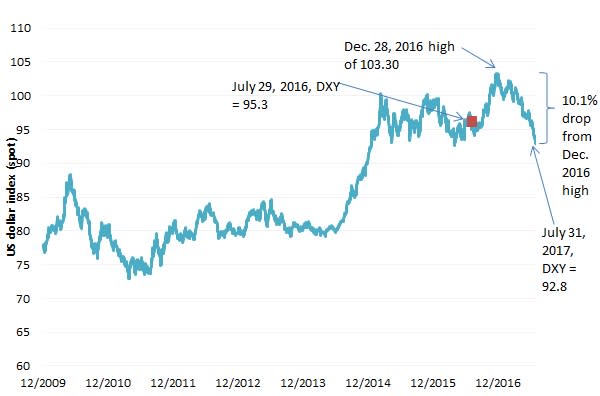Weak Dollar Could Spark Big Commodities Rally (DBC)
From Invesco: While the dollar moved higher against global currencies in 2014 and 2015, headlines touting the dollar’s strength continued long after its price trend flattened out. Since then, the Federal Reserve adopted tighter monetary policy, leading many market prognosticators to predict a renewed rise in the US dollar. I was not among them.
In fact, it has been my contention for nearly two years that the dollar holds limited upside potential. My reasoning centers in large part on global interest rate convergence. That is to say, if interest rates in Europe and other developed markets rise by a greater margin than rates in the US, tighter Federal Reserve policy wouldn’t necessarily equate to a stronger dollar. And indeed, this has been the case thus far in 2017. Interest rate spreads between the US and other regions have converged significantly. From Dec. 26, 2016, through July 31, 2017, the US dollar was down 10.1%, as measured by the US Dollar Index (DXY).
Movements in the US dollar since 2009

Source: Bloomberg L.P., July 31, 2017. Investments cannot be made directly into an index.
The effects of a lower US dollar on commodities
For investors in alternative assets, movements in the dollar can have significant implications. That’s because commodities priced on global exchanges in US dollars, such as oil, agricultural products and metals, have historically had an inverse relationship to the US dollar; i.e., a weak dollar has supported commodity prices, and vice versa.
I had my team run a regression analysis based on rolling 12-month returns for the US Dollar Index versus rolling 12-month returns for commodities, as measured by the DBIQ Optimum Yield Diversified Commodity Index. We ran our numbers beginning in 2010 to capture the post-financial crisis relationship. The results showed a significant -0.75 correlation between the US dollar and commodity prices, with the strongest commodity performance represented by the oval in the chart below.
Commodities performed best when the dollar was weakest
Source: Bloomberg L.P., July 31, 2017. Investments cannot be made directly into an index. Past performance is not a guarantee future results.
Some of our findings:
Since the financial crisis, when the dollar was down more than 5.6% on a rolling 12-month basis, the DBIQ Optimum Yield Diversified Commodity Index had an average total return greater than 30%. In fact, the worst return generated by the index during periods of dollar weakness was 18.9%.
With the dollar already down 10% from its post-election highs through July (and down 5.3% from pre-election levels), even a flat US dollar would put the rolling 12-month return of the US Dollar Index into that same -5.6% territory. Although past performance is no guarantee of future results, if the dollar fell to that degree, it could again put commodities into a rarefied historical risk/return category.
Using DXY’s high on Dec. 28, 2016, as a baseline, the US Dollar Index (currently trading near $93) would need only stay below $97.44 for commodities to land in the circled quadrant above by year-end 2017.
Of course, commodities could also benefit from improving supply and demand balances. Rising commodity prices could raise inflation expectations — putting upward pressure on long-term interest rates and likely keeping the Fed on course for further monetary tightening. In turn, increased interest rate volatility often bleeds into equity volatility, as higher rates reduce the present value of discounted future equity earnings. During times of stock market turbulence, commodities can serve as a viable alternative for investors.
Given these conditions, both diversified commodities and low volatility strategies seem like a good place to be right now, in my view. Those looking for a convenient and cost-effective way to invest in the commodity markets may wish to consider PowerShares’ lineup of commodity ETFs. PowerShares ETFs feature a rules-based, optimized yield strategy that seeks to optimize futures roll yield. PowerShares also offers a full suite of low volatility strategies.
Important information
Blog header image: YolLusZam1802/Shutterstock.com
Past performance is no guarantee of future results.
The DBIQ Optimum Yield Diversified Commodity Index is a rules-based index composed of futures contracts on 14 of the most heavily traded and important physical commodities in the world. An investment cannot be made into an index.
The US Dollar Index measures the value of the US dollar relative to a majority of its most significant trading partners.
Correlation is the degree to which two investments have historically moved in relation to each other.
Roll yield is generated by rolling a maturing futures contract to a later-dated futures contract.
Commodities, currencies and futures generally are volatile and are not suitable for all investors.
Investments focused in a particular industry or sector are subject to greater risk, and are more greatly impacted by market volatility, than more diversified investments.
The dollar value of foreign investments will be affected by changes in the exchange rates between the dollar and the currencies in which those investments are traded.
The risks of investing in securities of foreign issuers can include fluctuations in foreign currencies, political and economic instability, and foreign taxation issues.
Commodities may subject an investor to greater volatility than traditional securities such as stocks and bonds and can fluctuate significantly based on weather, political, tax, and other regulatory and market developments.
Many commodity ETFs are not mutual funds or any other type of investment company within the meaning of the Investment Company Act of 1940, as amended, and are not subject to the regulation thereunder.
The PowerShares DB Commodity Index ETF (NYSE:DBC) closed at $14.82 on Friday, up $0.03 (+0.20%). Year-to-date, DBC has declined -6.44%, versus a 11.71% rise in the benchmark S&P 500 index during the same period.
DBC currently has an ETF Daily News SMART Grade of B (Buy), and is ranked #37 of 130 ETFs in the Commodity ETFs category.
This article is brought to you courtesy of Invesco.
